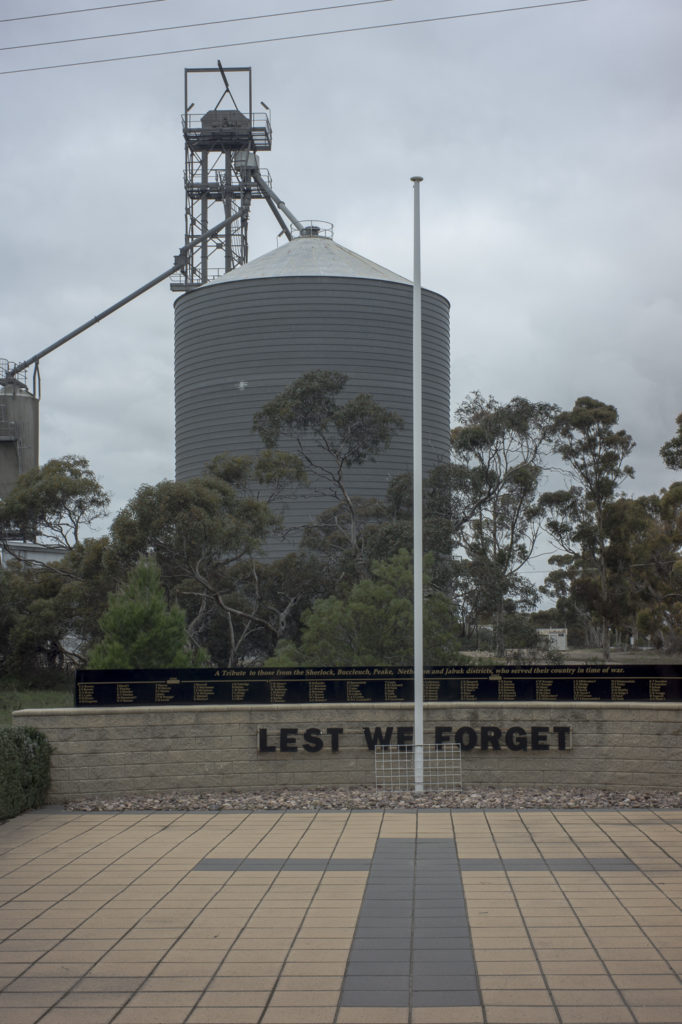On a recent day trip along the South Australian section of the Mallee Highway I stopped off at Peake to photograph the silo there. Peake is a grain receival centre on the rail line from Tailem Bend to Ouyen and like so many of the tiny settlements in the Mallee’s wheatlands it’s presence in the landscape is signalled by a cluster of cylindrical grain silos and a few modest cottages.
After, the photoshoot, whilst having my lunch on the picnic table in the public garden, I started thinking about the traditional split between modernist ‘art photography’ and documentary photography in the 1930s period.The duality of art’ versus ‘documentary’ basically means documentary as social critique and not initially intended as art within the institutional art gallery context. Traces of this duality remain today, even though documentary photography since the 1980s has lost much of its critical function and many documentary photographs were recuperated by the art gallery and sold as art. Documentary photographs are deemed have been taken straight from life and are seen as a truthful depiction of the world because it avoided the personal, subjective expression of media such as painting. The ethos is one of using the camera as an objective means of recording subjects that documented rather than interpreted. Photographic documents aspired to a ‘straight’ photographic style – direct and unmediated – that described ‘facts’ in a neutral, objective way.
After lunch I wandered around the hamlet/town to take a few snaps in the form of everyday, vernacular snapshots. One scene that I decided to scope was the local war memorial, which was at the eastern end of the public garden, just in front of the silo:

I assumed that though the two world wars passed quietly in the Mallee, those living there felt the need to establish a lasting memorial to those who had gone to fight for King and Country and to secure allegiances with the Mother Country. These war memorial sites of a once British Australia mourn and honour Australians who have served and died for their country. War memorials, such as this one at Peake, are the sacred places of settler Australia.
Ken Inglis, in his Sacred Places: War Memorials in the Australian Landscape, argues that the imagery, rituals and rhetoric generated around memorials constitute a civil religion, a cult of ANZAC. Sacred Places traces three elements which converged to create the cult: the special place of war in the European mind when nationalism was at its zenith; the colonial condition; and the death of so many young men in distant battle, which impelled the bereaved to make substitutes for the graves of which history had deprived them.
Today these memorials embody the Anzac Legend, which continues to lie at the centre of Australian identity. The Anzac Legend holds that Australian War Memorials represent the soul of the nation. The Legend’s current function and place within Australian culture is that of a creation story: it distills the Australian identity in one historical moment–the nation was born on the battlefields of Gallipoli. It is a creation story— nations are made in war—-but one that excludes the Frontier Wars in our Anzac Day commemorations.
As I wandered around the town the playing field on the other side of the Mallee Highway attracted me. It looked very spacious. So Maleko, who was accompanying me on the photo trip, and I went to explore it. A woman and child were playing on a swing in the playground next to the oval, so we gave them a wide birth. The scoreboard stood out—-signs of life in a town that, on the surface, appeared to be deserted.

The playing field looked to be a football oval rather than cricket one. What surprised me was substantiality of the club rooms, suggesting that this oval was the gathering place for the local regional community. The sports field is another kind of sacred place: <a href=”http://www synthroid 50 mcg.socialsciences.uwa.edu.au/__data/assets/pdf_file/0008/1859417/Tonts-.pdf”>sport binds the community together through contributing to community identity, sense of place, social interaction and good health.
When we are photographing the war memorials and sports fields in the Mallee we are not simply neutrally describing these mundane objects. These objects are endowed with meaning and they are so semiotically ladened that when we are photographing them we are also interpreting the culture of the region. Photographs apparently depicting mundane objects concomitantly function to convert the basic values of Mallee society. The photos taken are pictures and they become pictorial signs. When viewers looks at these pictures they are interpreting the pictorial meanings.
Although there is an indexical relation between the photographing the object, the traditional assumption that the photograph is so intimately associated with the singularity of the object depicted, that no distance is involved and so it could not even be considered to be a sign (eg., Fox Talbot’s conception of photography as the pencil of nature) needs to be rejected.

